SECOND BATTLE OF EL ALAMEIN: ROMMEL FAILS TO DELIVER VICTORY
El Alamein, Northwestern Egypt • October 23, 1942
In 1942 El Alamein was a mean little railway station roughly 275 miles/440 km east of the Libyan-Egyptian border. The First Battle of El Alamein was fought there between July 1 and 27, 1942, by a mixed German-Italian army under newly minted Field Marshal Erwin Rommel in command of Panzer Army Africa (Panzerarmee Afrika) and a mixed British Imperial-Commonwealth force under Gen. Claude Auchinleck (soon replaced by Lt. Gen. Bernard Law Montgomery) commanding the Eighth Army. Though a stalemate, the Eighth Army had stopped the Axis drive to overrun Egypt and seize the Suez Canal and the Middle Eastern and Persian (Iranian) oil fields, putting the “Desert Fox” on the defensive. Both sides took the next 3 months to prepare for a new offensive, the Second Battle of El Alamein.
During July and August 1942, Rommel received 35,000 new troops but no heavy weapons, tanks, or ammunition. Axis military assets were 116,000 servicemen, 547 tanks, 552 artillery pieces, and 770–900 aircraft. Montgomery, new at Eighth Army helm, had well over 1½ times the men under arms as the enemy had, nearly 2 times the tanks, over 4 times the artillery pieces, but slightly fewer aircraft, though the aircraft included the latest Supermarine Spitfires, Curtiss P‑40 Tomahawk fighters, and U.S.-piloted North American B‑25 medium bombers. Late on this date, October 23, 1942, and over the next 2 days in a phase known as the Break-In (Operation Lightfoot), Montgomery opened up with a deafening bombardment of Axis defenses. Enemy ears bled and the concussion of exploding shells caused many deaths. Bomber runs, flail tanks for clearing antitank and antipersonnel minefields, and infantry with fixed bayonets moved haltingly into the northern and southern sectors of the Axis’s eastern flanks (see map below). Casualties were heavy from stiff Axis resistance.
Rommel returned from European sick leave and took command of Axis forces at midnight on October 25, more than 48 hours after the Second Battle of El Alamein had begun. The first major battle of tanks and men, this in the northern sector, was 6 days of non-stop attack and counterattack. It petered out in a stalemate, both sides exhausted, with the Eight Army suffering 3,000 casualties. But Montgomery girded his loins once again and at 1 a.m. on November 2 the fight was on once more in the largest tank action of the battle (Operation Supercharge). By the end of the day, Rommel had less than 50 tanks able to move while Montgomery had 10 times that many. Rommel was also short of antitank guns and fuel.
That evening Rommel sent a message to Marshal of Italy Ugo Cavallero at Comando Supremo in Rome, Italy, who had direct authority over Rommel. Rommel was between a rock and a hard place and said his only hope was to “extricate the remnants” of his army. British intelligence intercepted Rommel’s plea to Comando Supremo, as well as one Hitler sent the next day ordering Rommel to stand and fight. The order was a death sentence for Panzer Army Africa, and Rommel and German Field Marshal Albert Kesselring, Commander in Chief South understood it as such. Kesselring implored Hitler to rescind his order, which the Fuehrer did on November 4. On the same day Lt. Gen. Wilhelm Ritter von Thoma, commander of the elite Afrika Korps, was captured and surrendered to Montgomery. That evening Rommel gave orders to retreat.
As German and Italian units began falling back, chased by the Eighth Army, the Panzer Army Africa front collapsed. Eighth Army’s casualties were 13,500 killed, wounded, or missing, about 8 percent of the force. Among German and Italian soldiers, 30,000 out of just over 100,000 were taken prisoner, two-thirds Italian. Killed or wounded may have amounted to 20,000. British Prime Minister Winston Churchill celebrated the victory at El Alamein—the first British victory over a German-led army—famously saying, “Now is not the end. It is not even the beginning of the end. But perhaps it is the end of the beginning.”
Second Battle of El Alamein (October 23 to November 11, 1942): Erwin Rommel Stumbles Badly
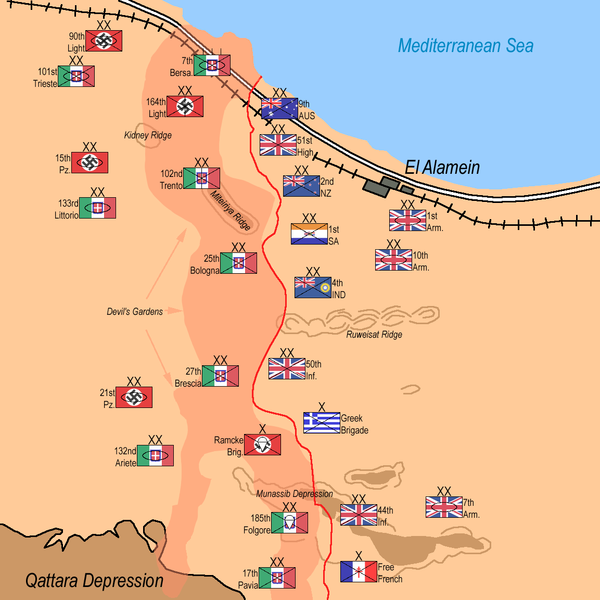 |
Above: Second Battle of El Alamein, deployment of Allied forces across a 40‑mile/64‑km front, October 23, 1942. The defeat of Erwin Rommel’s Panzer Army Africa at El Alamein early the next month prompted a long retreat of over 1,500 miles (2,400 km) and the eventual helter-skelter surrender of Axis forces in Tunisia, North Africa in May 1943. From their secure bases in North Africa and elsewhere in the Mediterranean basin the Allies launched their Italian Campaign by attacking the island of Sicily (Operation Husky, July 9 to August 17, 1943) and then the Italian mainland beginning in early September 1943. The Italian Campaign lasted until the surrender of the German Armed Forces in Italy on May 2, 1945, 3 days after Adolf Hitler committed suicide in his underground command bunker in the Nazi capital Berlin.
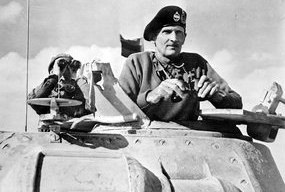 | 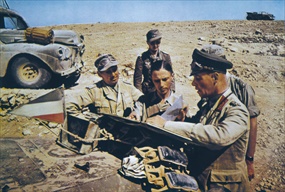 |
Left: In an open tank turret hatch sporting a black Royal Tank Corps beret adorned with the Tank Corps badge and a general’s insignia Bernard Law Montgomery (1887–1976) watches Eighth Army tanks advance during the Second Battle of El Alamein, November 2, 1942. Montgomery continued to command the Eighth Army in Sicily and Italy until late 1943, when he was recalled to England and given command of the 21st Army Group preparing for the 1944 D-Day invasion of Normandy in northwestern occupied France. He was promoted to the rank of field marshal on September 1, 1944, and remains one of the most renowned heroes in British military history. Fittingly, he was invested with the title 1st Viscount Montgomery of Alamein in 1946.
![]()
Right: Field Marshal Erwin Rommel (b. 1891) and staff consult maps of the Libyan battlefield. Leaving his Italian allies in the lurch after losing the Second Battle of El Alamein (he claimed the Italians lacked their own escape transport), Rommel and his panzer army continued their retreat westward, 1,100 miles/1,770 km across Northern Libya until, in January 1943, they crossed the border into the hills of Tunisia to meet their fate in the spring of 1943 in the final battles in North Africa. Shortly before the Axis surrender in Tunisia, Rommel was recalled to Europe and eventually given command of Army Group B in German-occupied France, tasked with preparing to meet the expected Allied invasion of Fortress Europe. He committed suicide on October 14, 1944, after being found vaguely connected to the July 20, 1944, plotters of the unsuccessful attempt on Adolf Hitler’s life.
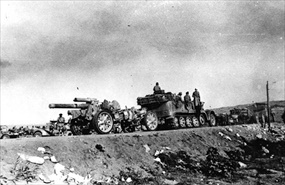 | 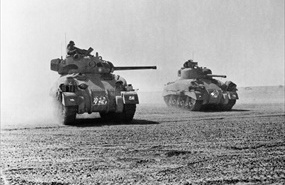 |
Left: Its carriage towed by a halftrack, a heavy German artillery weapon is moved into position during the first phase of the fighting at the Second Battle of El Alamein. The enemy had some 1,200 artillery pieces, half German and half Italian, compared to the Eighth Army’s 2,300.
![]()
Right: U.S.-supplied Sherman tanks of the 9th Queen’s Royal Lancers, 1st Armored Division, move across a stark desert landscape throwing up chocking sand and dust clouds during the Battle of El Alamein, November 5, 1942. Operation Supercharge, which began on November 2, was the final phase of Montgomery’s decisive battle at El Alamein. After a costly 2‑day slogging match to penetrate German defense lines and minefields, Eighth Army tanks finally broke through. Rommel ordered a withdrawal, and his broken formations retreated westwards across Libya, all the way to Tunisia. In November 1942, Anglo-American divisions landed in French Algeria and Morocco (Operation Torch). Rommel’s old army, trapped between U.S. and British armies, surrendered in mid-May 1943, 4 weeks after the Desert Fox had vacated his North African command post for eventually a new (and last) posting in German-occupied France.
From El Alamein to Tunisia, Axis Played Losing Hand, October 1942 to May 1943
![]()

 History buffs, there is good news! The Daily Chronicles of World War II is now available as an ebook for $4.99 on Amazon.com. Containing a year’s worth of dated entries from this website, the ebook brings the story of this tumultuous era to life in a compelling, authoritative, and succinct manner. Featuring inventive navigation aids, the ebook enables readers to instantly move forward or backward by month and date to different dated entries. Simple and elegant! Click
History buffs, there is good news! The Daily Chronicles of World War II is now available as an ebook for $4.99 on Amazon.com. Containing a year’s worth of dated entries from this website, the ebook brings the story of this tumultuous era to life in a compelling, authoritative, and succinct manner. Featuring inventive navigation aids, the ebook enables readers to instantly move forward or backward by month and date to different dated entries. Simple and elegant! Click 











